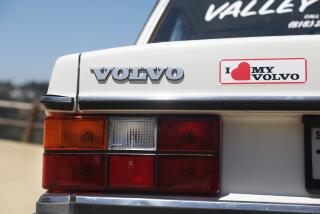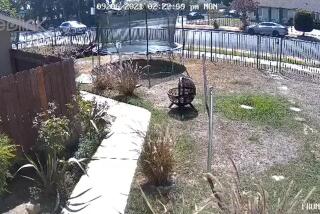Volvo Makes Smash Return
A tank of a car drives along in a rainstorm, then suddenly smashes into a metal wall. The battered vehicle--its front end demolished--is then rammed from behind by another car. The front and rear ends look like accordions, but the passenger compartment remains intact.
Welcome to Volvo’s return to network TV advertising.
Just last month, Volvo and its former agency were fined $150,000 each by the Federal Trade Commission for a misleading “Monster Truck” TV spot.
The ad featured a structurally reinforced Volvo that appeared to withstand the weight of an oversized truck running over it.
This time around, however, Volvo, its new ad agency and the production company took some extraordinary precautions to make certain that everything was on the up-and-up, according to the production company. The dramatic spot, filmed in Anaheim earlier this month by the Santa Monica production company Zuma Films, once again tries to prove the safety of Volvos. In this case, it’s the new Volvo 960.
Production crew members were asked to sign statements that said no tricks were used in the filming of the commercial. Two Los Angeles Dodger employees--who use radar guns to clock the speed of Ramon Martinez fastballs--were hired to verify the 30-m.p.h. speeds of the Volvos that crash in the ad.
And a firm that specializes in preparing cars for TV commercials was so careful to keep the demonstration authentic that crew members were even told to leave the spare tires and jacks in the trunks of the Volvos that crashed.
Some consumer advocates say that such documentation--and perhaps even more independent observers--should be used in virtually all demonstration advertising. Others say that Volvo--with its reputation on the line--had no choice but to take such unusual precautions.
In any case, with consumers increasingly skeptical about the believability of most advertising, such point-by-point documentation may soon become the rule rather than the exception.
“Not only are consumers skeptical of advertising, but so are most business people,” said Ken Bernhardt, marketing professor at Georgia State University in Atlanta. “When people see ads that are at odds with their personal experiences, it only increases their skepticism.”
Advertisers who get caught fudging the truth, such as Volvo, have a particularly difficult time regaining consumer trust in their advertising--and their products. “Even if you start telling the truth, you’re still stuck with a reputation for lying,” said Ivan Preston, marketing professor at the University of Wisconsin at Madison.
Officials from Volvo declined to discuss the new commercial that consumers will see in mid-October.
“About all I can say is that the theme for Volvo’s 1992 campaign will continue to be centered on safety,” said Robert Austin, manager of public relations.
The spot is one of seven new TV ads that Volvo plans to show its dealers at a national convention early next month. Also, Volvo will air a 30-minute “infomercial” on Saturday morning at 1 a.m. on KUSI in the San Diego market, and repeat it again at 8:30 a.m. on KTTY. The half-hour ad, which will be tested in San Diego for the next six weeks, promotes Volvo safety.
Executives from Volvo’s New York agency, Messner Vetere Berger Carey Schmetterer, are keeping tight-lipped about the network campaign. But they insist that the new demonstration ad was not made in reaction to the furor over last year’s spot.
“Everything is geared towards fighting a very difficult car market,” said Robert Schmetterer, president of the agency.
But in order to win back sales, experts say, Volvo also may have to win back its reputation.
“When a company like Volvo stooped so low, one can only wonder about what the other car companies are doing,” said Clarence Ditlow, executive director of the Washington, D.C.-based Center for Auto Safety. “I’d like to see all their claims submitted to an independent consulting firm for verification.”
Those involved in the production of the new crash commercial insist that there was no sleight of hand this time. “If there were any shenanigans going on, I would have refused to shoot,” said Doug Taub, a director at Zuma Films who has previously directed ads for both Infiniti and Lexus.
Added production manager Betsy Oliver, “Every attempt was made to verify everything that went on (during the shooting).” She said the production company even set up a video camera to document the filming of the commercial.
Although a crash dummy--and not a real person--was in the Volvo at the time of impact, the collision was so great that the commercial will show it in slow motion, Taub said. “It’s a pretty courageous attempt for Volvo to tell the public what they’re all about,” he said.
But Ditlow doesn’t believe that it’s all that courageous. He pointed out that most government safety tests are at 35 m.p.h.--not the 30 m.p.h. in the spot. And he says that Volvo would better prove its safety message by showing a side crash instead of a rear-end crash. Side crashes account for three times more fatalities than rear crashes, he said.
Actually, there was one thing simulated in the ad, Taub admitted. Everyone knows it seldom rains in Southern California. The “rain” in the commercial poured down from 10 water trucks.






